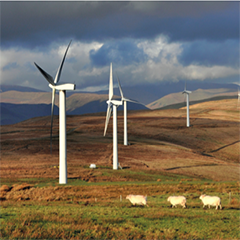In June this year, the UK government took a significant step forward in acknowledging the need to combat the global climate crisis by committing to a target of net zero carbon emissions by 2050. Renewable energy generation will have a critical role in meeting this obligation and establishing a low-carbon economy, but the country’s political and financial climate continues to severely limit the scale of onshore wind energy development.
Onshore wind has proven a major success story in the UK and is now amongst the cheapest options for new power generation, yet the government’s line on the development of new, and the repowering of old, onshore wind farms remains confused. As it stands, the government refuses to reconsider the policy, planning, and financial environment around large-scale onshore wind development.
Fortunately, this is not the only way forward for onshore wind power.
Businesses, wise to the impact of their operations on the climate, are not limited by the government’s lack of direction for renewable energy, and many are now aiming to take the initiative. This doesn’t just mean a pattern of firms choosing green energy providers, but involves an active choice to invest in onsite renewable energy generation systems. This begs the question, to what extent could the future of onshore wind be through onsite self-generation?
Lack of government direction
Over the last 3 years, the support mechanisms that had enabled the build-out of the UK’s onshore wind capacity have been rapidly phased out. The end of both the Renewables Obligation (RO) scheme and Contract for Difference (CfD) provision for onshore wind was designed to create fairer market conditions. However, instead of the withdrawal of subsidies stimulating the market, onshore clean energy generation has struggled to find a viable route to construction.
Almost 800 projects that have achieved planning consent, but do not yet have financial backing, could be built should utility-scale onshore wind be supported by financial incentives and opportunities. Together, these schemes would generate around 12 terawatt-hours of energy a year, equivalent to two thirds of the capacity of the recently dropped Hitachi nuclear project on Anglesey, Wales.
Planning policy has also had a role in severely limiting onshore wind. In England, government policy has enabled an environment where local councils are able to refuse the development of new projects and repowering of existing wind farms despite positive recommendations from planners. Whilst broad support from councils and their constituents is essential in planning for new projects and extending existing ones, the requirement for unanimous community support hands decision making power to the minority of people forcefully opposed to renewable energy infrastructure.
As it stands, with no way of entering power generation auctions, no subsidy support, and a hostile planning environment, the route to market remains very challenging for onshore wind developers. It is of major concern that neither finance nor policy is sufficiently supportive to roll out the volume of renewable energy required to meet the necessary carbon reduction requirements, or the country’s broader energy needs.




























